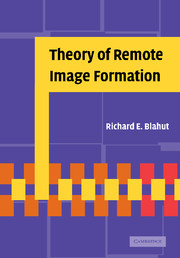Book contents
- Frontmatter
- Contents
- Preface
- Acknowledgements
- 1 Introduction
- 2 Signals in one dimension
- 3 Signals in two dimensions
- 4 Optical imaging systems
- 5 Antenna systems
- 6 The ambiguity function
- 7 Radar imaging systems
- 8 Diffraction imaging systems
- 9 Construction and reconstruction of images
- 10 Tomography
- 11 Likelihood and information methods
- 12 Radar search systems
- 13 Passive and baseband surveillance systems
- 14 Data combination and tracking
- 15 Phase noise and phase distortion
- References
- Index
4 - Optical imaging systems
Published online by Cambridge University Press: 19 August 2009
- Frontmatter
- Contents
- Preface
- Acknowledgements
- 1 Introduction
- 2 Signals in one dimension
- 3 Signals in two dimensions
- 4 Optical imaging systems
- 5 Antenna systems
- 6 The ambiguity function
- 7 Radar imaging systems
- 8 Diffraction imaging systems
- 9 Construction and reconstruction of images
- 10 Tomography
- 11 Likelihood and information methods
- 12 Radar search systems
- 13 Passive and baseband surveillance systems
- 14 Data combination and tracking
- 15 Phase noise and phase distortion
- References
- Index
Summary
The earliest imaging systems were optical imaging systems, and optical systems are still the most common imaging systems. Optical imaging systems that employ the simple lens are widespread; they are found both in biological organisms and in man-made devices. Much of optics, including the properties of the ideal lens, can be understood in the language of signal processing in terms of pointspread functions, convolutions, and Fourier transforms. More generally, we shall describe the propagation and diffraction of waves based on a two-dimensional pointspread function. In this setting, the Huygens—Fresnel principle of optics will be presented simply as a special case of the convolution theorem of the two-dimensional Fourier transform.
In principle, the diffraction of electromagnetic waves should be explained directly from Maxwell's equations, which give a complete description of electromagnetic fields. However, there may be mathematical difficulties when starting from first principles because there may be concerns about how to model a given problem, or how to specify a consistent and accurate set of boundary conditions. It may be difficult to formulate the boundary conditions at a level of detail needed to apply Maxwell's equations, while the weaker conditions needed for diffraction theory may be readily apparent. This is why we formulate the theories of diffraction as distinct from, but subservient to, electromagnetic theory.
- Type
- Chapter
- Information
- Theory of Remote Image Formation , pp. 111 - 152Publisher: Cambridge University PressPrint publication year: 2004



